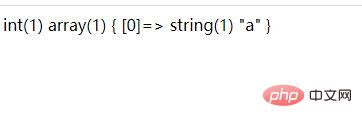 Backend Development
Backend Development
 PHP Problem
PHP Problem
 What are regular expression functions in PHP? (detailed instructions for use)
What are regular expression functions in PHP? (detailed instructions for use)
What are regular expression functions in PHP? (detailed instructions for use)
The previous article introduced you to "What are the pattern modifiers in PHP? How are they used? (With detailed explanation) 》, this article will continue to introduce to you and let’s talk about the regular expression functions in PHP? How to use it (with code)

Regular expression function
preg. grep() returns the array unit that matches the pattern ( One-dimensional array)
First, we first understand the array unit (preg_prep) that returns the pattern matching, and then we start writing parameters. The first parameter @param1 (pass in the regular expression to be matched formula); the second parameter @param2 (array to be matched); the third parameter @param3 (optional parameter);
We first define an array, $arr, and then we define the regular expression Formula $pattern, then output the result (result) of (preg_grep), and finally we print out $result; when we print the results, we find that we did not print out those pure letters,
<?php $arr = array(1,'abc','2','c3c','d'); var_dump($arr); $pattern = ' /\d/' ; $result = preg_grep($pattern,$arr ,0); var_dump($result); ?>
Code running results:
 Let’s continue to understand (the function that performs a regular match) preg_match. We define the regular expression $pattern,
Let’s continue to understand (the function that performs a regular match) preg_match. We define the regular expression $pattern,
<?php //preg_ match() 进行一次正则匹配 $pattern='/\w/'; $str = '!@a#$b%^c&*d(' ; $result = preg_match($pattern, $str,$match); var_dump($result); var_dump($match); ?>
The code running result:

The above code shows that if we want to do some queries or matching in the future, we just want to test whether there is what we want. If it is, it means success, and if it is not, it means failure.
Contrary to the function we mentioned above, there is also //preg_ match_ _all(), which performs regular matching to obtain all matching content. Copy the above code and add all after $result = preg_match to get $result = preg_match_all , the result of running the code is that all the results we input are output, and the result returns a two-dimensional array,
<?php //preg_ match() 进行一次正则匹配 $pattern='/\w/'; $str = '!@a#$b%^c&*d(' ; $result = preg_match_all($pattern, $str,$match); var_dump($result); var_dump($match); ?>
The result of running the code:

Recommended learning : "PHP Video Tutorial"
The above is the detailed content of What are regular expression functions in PHP? (detailed instructions for use). For more information, please follow other related articles on the PHP Chinese website!

Hot AI Tools

Undresser.AI Undress
AI-powered app for creating realistic nude photos

AI Clothes Remover
Online AI tool for removing clothes from photos.

Undress AI Tool
Undress images for free

Clothoff.io
AI clothes remover

AI Hentai Generator
Generate AI Hentai for free.

Hot Article

Hot Tools

Notepad++7.3.1
Easy-to-use and free code editor

SublimeText3 Chinese version
Chinese version, very easy to use

Zend Studio 13.0.1
Powerful PHP integrated development environment

Dreamweaver CS6
Visual web development tools

SublimeText3 Mac version
God-level code editing software (SublimeText3)

Hot Topics
 1381
1381
 52
52
 PHP regular expression validation: number format detection
Mar 21, 2024 am 09:45 AM
PHP regular expression validation: number format detection
Mar 21, 2024 am 09:45 AM
PHP regular expression verification: Number format detection When writing PHP programs, it is often necessary to verify the data entered by the user. One of the common verifications is to check whether the data conforms to the specified number format. In PHP, you can use regular expressions to achieve this kind of validation. This article will introduce how to use PHP regular expressions to verify number formats and provide specific code examples. First, let’s look at common number format validation requirements: Integers: only contain numbers 0-9, can start with a plus or minus sign, and do not contain decimal points. floating point
 How to validate email address in Golang using regular expression?
May 31, 2024 pm 01:04 PM
How to validate email address in Golang using regular expression?
May 31, 2024 pm 01:04 PM
To validate email addresses in Golang using regular expressions, follow these steps: Use regexp.MustCompile to create a regular expression pattern that matches valid email address formats. Use the MatchString function to check whether a string matches a pattern. This pattern covers most valid email address formats, including: Local usernames can contain letters, numbers, and special characters: !.#$%&'*+/=?^_{|}~-`Domain names must contain at least One letter, followed by letters, numbers, or hyphens. The top-level domain (TLD) cannot be longer than 63 characters.
 How to match timestamps using regular expressions in Go?
Jun 02, 2024 am 09:00 AM
How to match timestamps using regular expressions in Go?
Jun 02, 2024 am 09:00 AM
In Go, you can use regular expressions to match timestamps: compile a regular expression string, such as the one used to match ISO8601 timestamps: ^\d{4}-\d{2}-\d{2}T \d{2}:\d{2}:\d{2}(\.\d+)?(Z|[+-][0-9]{2}:[0-9]{2})$ . Use the regexp.MatchString function to check if a string matches a regular expression.
 Master regular expressions and string processing in Go language
Nov 30, 2023 am 09:54 AM
Master regular expressions and string processing in Go language
Nov 30, 2023 am 09:54 AM
As a modern programming language, Go language provides powerful regular expressions and string processing functions, allowing developers to process string data more efficiently. It is very important for developers to master regular expressions and string processing in Go language. This article will introduce in detail the basic concepts and usage of regular expressions in Go language, and how to use Go language to process strings. 1. Regular expressions Regular expressions are a tool used to describe string patterns. They can easily implement operations such as string matching, search, and replacement.
 PHP regular expressions: exact matching and exclusion of fuzzy inclusions
Feb 28, 2024 pm 01:03 PM
PHP regular expressions: exact matching and exclusion of fuzzy inclusions
Feb 28, 2024 pm 01:03 PM
PHP Regular Expressions: Exact Matching and Exclusion Fuzzy inclusion regular expressions are a powerful text matching tool that can help programmers perform efficient search, replacement and filtering when processing text. In PHP, regular expressions are also widely used in string processing and data matching. This article will focus on how to perform exact matching and exclude fuzzy inclusion operations in PHP, and will illustrate it with specific code examples. Exact match Exact match means matching only strings that meet the exact condition, not any variations or extra words.
 How to verify password using regular expression in Go?
Jun 02, 2024 pm 07:31 PM
How to verify password using regular expression in Go?
Jun 02, 2024 pm 07:31 PM
The method of using regular expressions to verify passwords in Go is as follows: Define a regular expression pattern that meets the minimum password requirements: at least 8 characters, including lowercase letters, uppercase letters, numbers, and special characters. Compile regular expression patterns using the MustCompile function from the regexp package. Use the MatchString method to test whether the input string matches a regular expression pattern.
 Chinese character filtering: PHP regular expression practice
Mar 24, 2024 pm 04:48 PM
Chinese character filtering: PHP regular expression practice
Mar 24, 2024 pm 04:48 PM
PHP is a widely used programming language, especially popular in the field of web development. In the process of web development, we often encounter the need to filter and verify text input by users, among which character filtering is a very important operation. This article will introduce how to use regular expressions in PHP to implement Chinese character filtering, and give specific code examples. First of all, we need to clarify that the Unicode range of Chinese characters is from u4e00 to u9fa5, that is, all Chinese characters are in this range.
 What are the regular expression wildcards?
Nov 17, 2023 pm 01:40 PM
What are the regular expression wildcards?
Nov 17, 2023 pm 01:40 PM
Regular expression wildcards include ".", "*", "+", "?", "^", "$", "[]", "[^]", "[a-z]", "[A-Z] ","[0-9]","\d","\D","\w","\W","\s&quo



